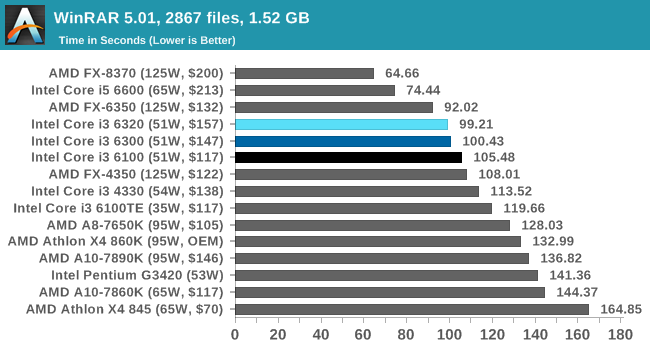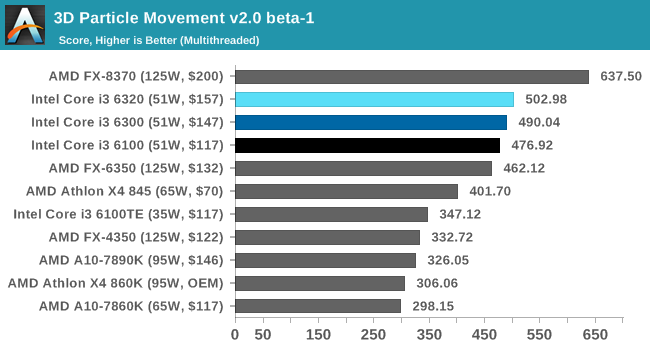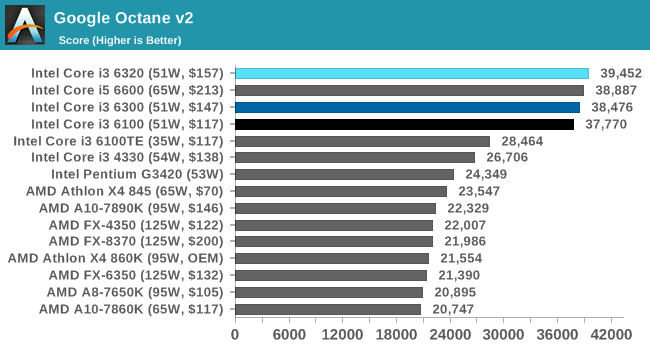The Skylake Core i3 (51W) CPU Review: i3-6320, i3-6300 and i3-6100 Tested
by Ian Cutress on August 8, 2016 9:00 AM ESTReal World Performance
The dynamics of CPU Turbo modes, both Intel and AMD, can cause concern during environments with a variable threaded workload. There is also an added issue of the motherboard remaining consistent, depending on how the motherboard manufacturer wants to add in their own boosting technologies over the ones that Intel would prefer they used. In order to remain consistent, we implement an OS-level unique high performance mode on all the CPUs we test which should override any motherboard manufacturer performance mode.
All of our benchmark results can also be found in our benchmark engine, Bench.
Dolphin Benchmark: link
Many emulators are often bound by single thread CPU performance, and general reports tended to suggest that Haswell provided a significant boost to emulator performance. This benchmark runs a Wii program that raytraces a complex 3D scene inside the Dolphin Wii emulator. Performance on this benchmark is a good proxy of the speed of Dolphin CPU emulation, which is an intensive single core task using most aspects of a CPU. Results are given in minutes, where the Wii itself scores 17.53 minutes.

Skylake saw a good boost with our Dolphin benchmark, and it remains a single-thread driven event. The 100 MHz difference between the i3-6320 and i3-6300 amounts to just over a second difference, but one step back to the i3-6100 is another 42 seconds. This is one of the few instances where the 3 MB of L3 cache on the i3-6100 makes a significant difference. The i5-6600 sits in the middle of our i3 parts due to its lower CPU frequency but higher cache.
WinRAR 5.0.1: link
Our WinRAR test from 2013 is updated to the latest version of WinRAR at the start of 2014. We compress a set of 2867 files across 320 folders totaling 1.52 GB in size – 95% of these files are small typical website files, and the rest (90% of the size) are small 30 second 720p videos.

WinRAR is a variable thread test, so the CPUs with more threads all pull ahead of the i3 parts. Again, we see a crescendo from the i3-6320 to the i3-6300 and the i3-6100, with the i3-6100 being slightly further out due to its reduced L3.
3D Particle Movement v2
The second version of this benchmark is similar to the first, however it has been re-written in VS2012 with one major difference: the code has been written to address the issue of false sharing. If data required by multiple threads, say four, is in the same cache line, the software cannot read the cache line once and split the data to each thread - instead it will read four times in a serial fashion. The new software splits the data to new cache lines so reads can be parallelized and stalls minimized. As v2 is fairly new, we are still gathering data and results are currently limited.

The updated 3DPM benchmark likes good cache management and a high frequency with lots of threads. As from our Carrizo review, the AMD X4 845 does really well here, beating the i3-6100TE which has a much lower frequency. For the i3 parts, we see a regular staircase between the three, outpacing the much older FX-6350.
Web Benchmarks
On the lower end processors, general usability is a big factor of experience, especially as we move into the HTML5 era of web browsing.
Mozilla Kraken

Kraken also enjoys Skylake CPUs, with a preference for high frqeuency parts as well. The regular staircase is in effect between the three, showing how L3 cache makes little difference here.
Google Octane v2

Octane has a similar performance to Kraken, with the Skylake CPUs out in top with the staircase results. The i5-6600 sits in the middle, despite having four physical cores, but restrained to four threads. Because of this and our regular staircase, we can see that the L3 cache plays little role here and the threads are very lightweight. The resources on the FX CPUs unfortunately do not do well here.










94 Comments
View All Comments
nightbringer57 - Monday, August 8, 2016 - link
Hard question.My guess would be that such models are core i3s with defective iGPUs, and overall lower binned, mostly destined to OEMs that could negotiate a lower price for almost identical performance (3% less frequency = no noticeable difference), in models with typically low-end dGPUs. While at the same time not price dumping the other i3s in the retail market (prices are always much more variable than the MSRP in the retail market and I would guess you could find them for slightly cheaper).
Once again, 3% frequency and 3W TDP don't make for much of a difference.
DanNeely - Monday, August 8, 2016 - link
Yeah it definitely looks like a binning dumpster - trying to salvage the last bit of value from chips with working HT but a damaged GPU that needed partially fused off. If the list price was marginally lower I wouldn't've thought anything of it, although I suppose Intel could be willing to offer better volume discounts behind the scenes.extide - Monday, August 8, 2016 - link
Yup, the 6098P has GT1 graphics, with only 12 EU's, vs GT2 and 24 EU's in all of the other i3's. I bet they are harvesting chips with bad EU's. As far as price goes, I am sure that whatever OEM is buying those is paying less than the prices on ARK. Intel is kinda famous for having tons of CPU's all the same price, but the OEM's buying them are going ot be paying totally different prices than whats on the price sheets/ARK. I would imagine the prices that they negotiate end up being lower for the lower models and higher for the higher models even if they are all listed the same on ARK.Ratman6161 - Monday, August 8, 2016 - link
I did a quick check and did not find any 6098's for sale on New Egg or Amazon. But I could see a position for them if the street price is less than a 6100. For anyone who is not going to use the integrated graphics anyway, saving a few more bucks on the CPU could be worthwhile. Has to be cheaper than a 6100 though because otherwise you would just get the 6100.Since I'm not finding any for sale, I'm also wondering if they will mainly be sold to OEM's and end up with people who wouldn't know the difference anyway in their low end Dell or HP desktop?
kuntakinte - Monday, August 8, 2016 - link
Nice selective test :-). In comparision with rather old i3-4330 (3,5GHz) Skylake shines.But maybe you can add to the charts fastest i3 Haswell (i3-4370, 3,8 GHz). It's exactly in the middle of the tested three cpu's. But then i supose that Skylake "advantage" will drop to mere 2-5%.
lefty2 - Monday, August 8, 2016 - link
Actually, I was surprised that the iGPU sees zero improvement since Haswell.ImSpartacus - Monday, August 8, 2016 - link
This is an awesome subject that I've fascinated by. Good to see a proper review.AndrewJacksonZA - Monday, August 8, 2016 - link
Interesting that you kept the WinRAR test and let the 7-Zip test go to the "Legacy" section. Why? Did you do a coin toss between the two? :-)stephenbrooks - Monday, August 8, 2016 - link
Right... a friend actually persuaded me to migrate *from* WinRAR *to* 7-Zip because it offered better compression.DanNeely - Monday, August 8, 2016 - link
As a file compression utility, 7zip is better than WinRar. Where Winrar stands out is as one of the very few real world applications whose performance is hugely dependent on memory speed; which makes it a great benchmark.